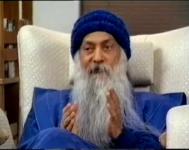[A sannyasin says: I was doing buddhist meditation for two years.... I kept falling asleep!]
Mm, that's possible in a buddhist meditation... very possible. That's why zen masters have to keep a staff continuously to hit the disciples, because they are always dozing. The whole method is so silent, so relaxing, that the natural possibility is to fall into sleep. Whenever we relax, whenever we are silent, we fall asleep, so with relaxation there is a deep association with sleep.
That's what we have been doing for our whole life -- and the buddhist meditation depends on relaxation. So once you relax, the mind gets the hint that now you are ready to sleep, because that is the only way it has come to know sleep. It has no other way, no other experience. It cannot figure it out -- if you are relaxed, why aren't you going to sleep?
[Osho said it is a conditioning -- just like the conditioned response of Pavlov's dogs who were trained to respond to the ring of a bell by the subsequent reward of meat. After a time the meat could be withheld, but the dogs would still continue to salivate at the sound of the bell.]
To fall asleep, relaxation is a must, but relaxation is not necessarily a step towards sleep. It can become a step towards meditation too. But then a great change of your past associations is needed, otherwise you will fall asleep. But it is good that you tried. With my meditations it will never happen because they are so active. They create a turmoil in your energy, a chaos; you cannot fall asleep. And for the modern mind, that seems to be the best possibility.
In the old days when Buddha was here and when he invented his meditations, people were absolutely relaxed. In India in those days -- all over the world in those days -- people were sleeping almost twelve hours because there was no electricity, no kerosene, no light or anything. Even now in indian villages, that is the case. Thousands of villages have no light, so the sunset is the end of the day. Then what to do? You gossip a little or sing a little, or dance a little and then go to sleep. By the time it is eight, the whole village is fast asleep -- and there is no point in getting up too early.
So people have been sleeping deeply. When a person has slept absolutely, then even if relaxation happens, sleep will not come, because the sleep need is fulfilled. And people were working hard. They were working the whole day as they still do in the East. Technology had not yet replaced their work. So when you work hard and you sleep well, your need is completely
el relaxed, the seou sit silently, relaxation will come, sleep will not follow, and your energy will start moving in a new direction.
Relaxation is a step towards both sleep and samadhi. After relaxation there is a bifurcation. Either you go into sleep or you go into samadhi; these are the two possibilities.
It is very difficult for the modern mind to feel relaxed in the first place. But if you feel relaxed, the second problem is not to fall asleep. People are not sleeping as much as they should, as much as the body needs biologically, and they are not working hard either. Without hard work, sleep is impossible. You have to do hard work, then the body creates the need to relax. So people are not working -- hard work has disappeared -- and they are not sleeping well.
So whenever they start meditating -- any meditation like a buddhist meditation -- they start falling asleep. Hence my insistence on active and dynamic methods. Once you start tasting -- once that opening has started functioning and a few glimpses of satori have come to you through active methods -- then you can again start buddhist methods, and they will be tremendously meaningful.
So do a few groups here -- and simply do what I say. It is easier that way!
- Osho, “The Passion for the Impossible, #18”




 https://oshofriends.com/talks_on_meditation/46780
https://oshofriends.com/talks_on_meditation/46780